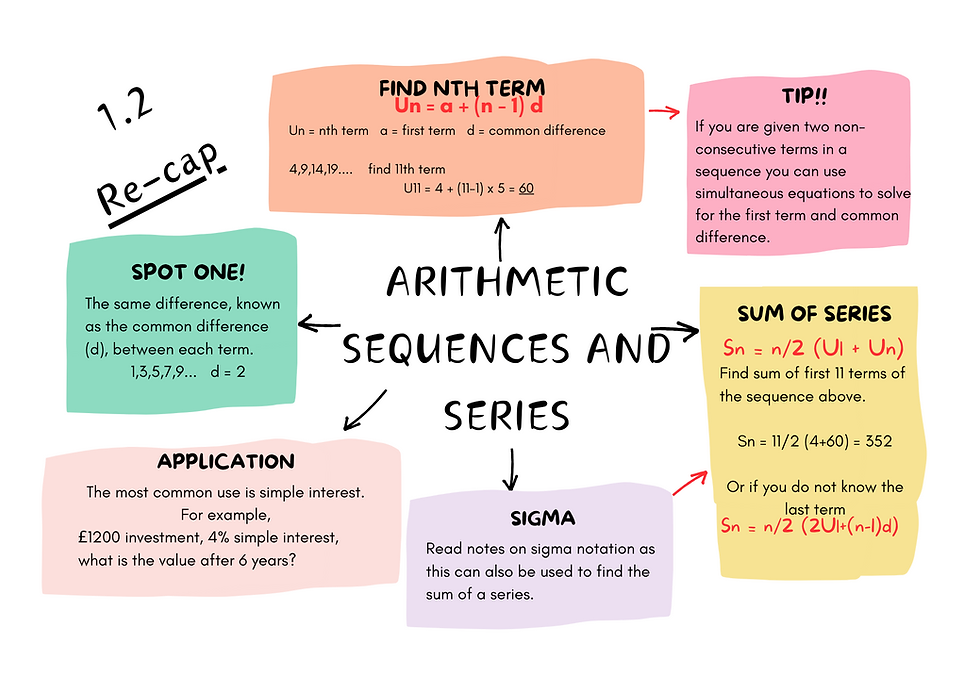
Task 1 - Arithmetic Sequence
Understand and work with arithmetic sequences, including the formulae for nth term.
Before we begin I want you to think about what you already know about sequences. Try to write a definition of sequence down, write it down do not just think of a definition.
Sequences
A sequence is a set of numbers written in a particular order. We sometimes write U1 for the first term of the sequence, U2 for the second term, and so on. We write the nth term as Un.
You should already be familiar with sequences from Years 10 and 11 maths. Refresh your memory by completing these questions.
Un = 4n+5, use the formula to find the first five terms of the sequence where n = 1,2,3...
Un = 1/n4, use the formula to find the first four terms of the sequence where n = 1,2,3... What is the tenth term?
Can you remember the first eight terms of the Fibonacci Sequence?
Un = (−1)n+2/n, write the first five terms.
Series
A series is a sum of the terms in a sequence. If there are n terms in the sequence and we evaluate the sum then we often write Sn for the result, so that Sn=U1+U2+U3+...+Un.
Working with the series below
1,2,3,4,5...
S1 = 1 The sum of the series to the first term is the first the, 1.
S2 = 1+2 = 3 The sum of the series to the second term is the first and second term combined.
S3 = 1+2+3 = 6 The sum of the series to the third term is the first, second and third term combined.
Your go. Answer these questions in your book.
Find S1, S2, S3, S6 for these sequences.
1,3,5,7,9...
6,4,2,0,-2...
0,10,20,30...
Useful Calculator Skills
Arithmetic Sequences
An arithmetic sequence, or AS, is a sequence where each new term after the first is obtained by adding a constant d, called the common difference, to the preceding term. If the first term of the sequence is a then the arithmetic sequence a, a+d, a+2d, a+3d, ... where the nth term is
a+(n−1) d.
You are going to work through a series of video lessons from an Australian teacher as well as TLMaths. I chose these videos because they are really easy to follow and very good at covering the topic. However, in Australia, they use T1, T2... instead of U1, U2... so bear that in mind.
Watch Introduction to Arithmetic Sequences by TLMaths.
Watch Introduction to Arithmetic Sequences by McClatchey Maths.
Complete this exercise on arithmetic sequences on Transum. You should be able to finish level 2 comfortably but you will need to finish the unit to complete level 4.
If you need more practice try this worksheet from Corbett maths.
No Common Difference, No Problem!
So far you have been working with problems where you have been given consecutive numbers or the common difference. But what if you do not know the common difference and are not given consecutive numbers?
To work out the nth term in these problems you will need to use simultaneous equations. Some of you will love simultaneous equations some of you will not. If you are in the not group please take a deep breath and do not panic. I am going to walk you through step by step and give you plenty of practice so that you feel more comfortable moving forward.
Begin by watching the Arithmetic Sequences and Simultaneous Equations video by McClatchey Maths.
For a second explanation go to TLMaths: 5.19 Arithmetic: 3rd term is 10, 25th term is 142.
I am not going into simultaneous equations in depth here but it is important you know how to solve them with and without a calculator. Check out the calculator unit of work if you need a recap.
What if it asks for nth Term?
You already know how to find a specific term e.g. find the 80th term of a sequence but you may be asked to find the nth term.
In these questions, you are just being asked to give a formula for the nth term.
Watch TLMaths: Finding the nth term.
How Many Terms Are in a Sequence?
You may also be given a section of a finite sequence and the value for the nth term and asked how many terms are in the sequence. Again, this is all about using the formula and substituting in the information.
Watch TLMaths: How many terms in an arithmetic sequence?
Task 2 - Arithmetic Series
Understand and work with arithmetic sequences and series, including the formulae for nth term and the sum to n terms.
There are two useful formulas for working out the sum of a finite arithmetic sequence, a series. Which one you use will depend on the information you are given. For one formula you need to know d for the second you need to know the start and end terms.
Watch TLMaths: Introducing Arithmetic Series.
Watch McClatchey Maths.
Watch the following three TLMaths videos, they are short so they won't take long.
The sum of the terms of an arithmetic sequence gives an arithmetic series. If the starting value is a and the common difference is d then the sum of the first n terms is
Sn=1/2 n(2a+(n−1)d)
If we know the value of the last term ℓ instead of the common difference d then we can write the sum as
Sn=1/2 n(a+ℓ)
Task 3 -Sigma
Use of sigma notation for sums of arithmetic sequences.
Watch TLMaths: Introducing Sigma Notation and then Writing a Sum Using Sigma Notation.
Task 4 - Practice
Go and work through Unit 9 of Algebra 1 at Khans Academy. Go all the way down to Quiz 1. Some terms they use may be different but that is ok. It is good to understand mathematical terminology from other countries. Then go to Unit 18 Algebra at Khans Academy and work through Basic Sigma notation to the end of Arithmetic Series.
Complete this exercise on arithmetic sequences on Transum. Finish levels 3 and 4 this time.
Task 5 - Using Arithmetic Sequences and Series
We can use our knowledge of Arithmetic sequences and series to help us with several real-life situations. We are going to look briefly at two situations: simple interest and depreciation. Both of these are covered more fully in the module on financial maths.
Watch MacClutchey Maths: Simple Interest. Again, in Australia, they use the same formula but different letters in the UK the formula for simple interest is
A = P (1 +rt)
A = final amount P = Principal balance r = annual interest rate t = years
Here is a great online unit of work that connects simple interest and arithmetic sequences.
Watch McClutchey Math Depreciation video.
Here is a great textbook unit on simple interest and depreciation.
You can choose to work through the examples and problems and master depreciation now or just look it over to understand the relationship between sequences and financial maths.
Task 6 - Consolidate
In your journal use a double page to begin writing about sequences, include:
Definitions for arithmetic sequence and series.
Important formulas.
Examples of using the formulas.
Real-life examples.
Note anything you have difficulty with (this will help you when it comes to revising).
Add this sheet to your notebook.

Comments